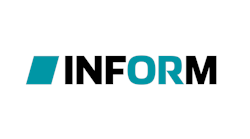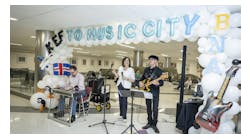For Stuttgart Airport (STR), the opening of its Terminal 3 set in motion the need for new Information Technology (IT) systems that could better manage the airport with the terminal facilities. Its existing Flight Information Display Software (FIDS) was not up to the task.
STR knew it needed a fully-integrated IT system with a central Airport Operational Database (AODB). In August 2002, the airport sought out a strategic IT partner to develop the right solution and determined that Inform GmbH was the partner it needed. According to Michael Gassner, director of consulting Aviation for Stuttgart Airport, STR deployed a new AODB, along with various Inform modules to optimize its entire airport operations and process chain, from flight planning, rostering and dispatching to invoicing.
Ramp Operations and Airport Infrastructure
One area in particular targeted for improvement was ramp operations. Specifically, Stuttgart Airport had three chief goals:
- To improve overall efficiency of ramp operations as ground handling was a major loss maker at that time
- To keep track of staff and ground support equipment in order to achieve better transparency of the ramp operation by collecting task information and time stamps (e.g., which employee is serving on which flight, status of each task, etc.)
- To improve its staff’s situational awareness by sharing information (e.g., dangerous goods in the hold
Prior to the initiative, STR’s dispatch process was based on a manual, pen and paper process using magnetic boards. Communication between dispatchers and employees occurred via radio or task sheets. There were many sub-systems to this process; some manually created such as those using small Excel tools. Collecting and sharing information in this way proved to be a very time-consuming task. As part of its strategic vision for a fully-integrated IT system for its operation, Stuttgart Airport wanted to embed the ramp operation/ground handling part of its operation into the solution, which subsequently formed the basis for the holistic system now benefitting the airport.
Along with the ramp operations, by also managing the airport’s infrastructure, the integrated solution served to optimize Stuttgart Airport’s allocation of stands, gates and check-in counters; control of doors inside the terminal for separating domestic and international customers and passenger flows; and management of interfaces to the FIDS.
The Project Team, Process and System
The airport brought together an interdisciplinary team consisting of members of the operation, as well as those from its IT department. Inform assembled a team of experienced airport IT systems, project management and subject matter experts for each targeted department. The airport’s project lead was Eric Geigenmueller, head of IT projects-aviation. He was joined by Hans-Steffen Daehn in the role of Inform project manager. Gassner noted that, together, this Project Team set out to:
- Establish joint specifications
- Implement the core airport management systems, especially the AODB
- Implement the pilot department (i.e., ramp passenger bus operation), inclusive of:
- Specifications
- Modeling in the tools including the development of new functionalities
- Testing
- Go-Live
- Roll-Out of further departments
Implementing the new system while it was still under development was a challenge the project team faced. They also had to create a perfect fit of processes and systems so that all processes take place in the systems in order to avoid shadow systems. These challenges made it clear that STR’s project was not a routine IT project, but rather a change-agent project since the airport’s processes required changing.
Stuttgart Airport implemented the AODB, along with seasonal flight planning and daily flight planning systems. GS Planning for both stands and staff & equipment, GS RealTime for stands and staff & equipment, GS rostering, GS RealTime for staff (incorporating mobile device functionality), and message broker (for managing all external interfaces) solutions were deployed. Also implemented were business intelligence software and skybilling integrated in SAP). Subsequently, other modules such as the GS Workforce Plus were added. The performance features offered by these collective technologies included: the ability to facilitate a single integrated system, as well as real-time dispatching, including through mobile devices for documenting tasks, advanced reporting with all operational data accessible for future reviews, and a scenario capability. Together, they delivered fully-transparent airport operations for Stuttgart Airport.
The project, which began in 2002, had its core phase completed in 2006. When viewed in the context of today’s airport IT projects, this may seem lengthy. Back then, however, many of the features and even some of the modules were being developed from scratch. Once the core phase was completed, all of the general airport management functionalities were implemented, including the terminal management component and the largest ground handling departments. It was a fully-integrated project.
Benefits Derived
Stuttgart Airport’s IT project yielded many notable benefits for the airport; its staff and passengers. Better decision-making has resulted stemming from the holistic process transparency. Instead of using many different legacy systems, there is one central system for the integrated management and steering of the airport. Staff utilization has increased, as has revenue due to better tracking of special services. Combined, there has been a marked economic turnaround in the airport’s ground handling department which is now operating profitably.
The airport’s ground handling staff too is participating in and benefiting from their department’s economic success. A bonus model has been introduced wherein each individual can participate in the better economic results based on their individual contributions. Because of the heightened transparency, the airport also is able to achieve better planning and a more balanced workload. By embedding staff in the rostering process and accommodating staff members’ scheduling preferences, the process has been individualized, increasing morale and productivity.
Since the system has been implemented, Stuttgart Airport has achieved a significant increase in service quality as evidenced by the various quality awards it has received from a considerable number of airline such as the “Quality Award World” from Lufthansa, the “Quality Award World” from British Airways and the “Grand Slam Award” from Delta. The airport also can site that it remains one of the most punctual airports in Germany.
Rolling-out The Optimization Software to Other Departments
Noting the benefits derived within its ground handling department and ramp operations, Stuttgart Airport is continuously enhancing the use of the system by rolling-out the optimization software in other departments together with adding new functionalities. This includes the application of GS Workforce Plus to increase the level of automation in the roster creation process through to the introduction of Airport Collaborative Decision Making (A-CDM).
Dirk Spengler, director infrastructure & IT for Stuttgart Airport and initiator of the project, summarized, “One of the key success factors is that the project somehow never stopped and the system is continuously being enhanced and adapted to meet changing needs.”
His board colleague and counterpart from the Aviation side in the steering group, Wolfgang Mueller, senior vice president aviation, added, “This project has led to many other airports visiting Stuttgart Airport to see what we have achieved. It’s been a real showcase for the airport. It was also the impetus for the foundation of Stuttgart Airport’s daughter company, Cost Aviation, which provides help to external customers worldwide by sharing the knowledge and experience the airport has gained through this project.”
Altay Fellah is Vice President, Business Development, Aviation Division of INFORM GmbH (Aachen, Germany). Altay has over 20 years of experience in different sectors of the aviation industry. He began his aviation career in ground handling. He joined INFORM in 1997 as a Consultant and Project Manager, conducting a series of international projects within Europe, North America, Asia, the Middle East, Russia and Africa. As Vice President, Business Development at INFORM, he is responsible for the Aviation Division’s marketing and sales activities. He holds a Business Administration degree from EMU University and a Master’s in Business Administration from Bradford University School of Management.




